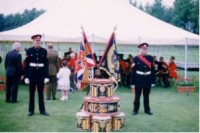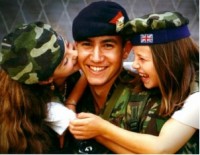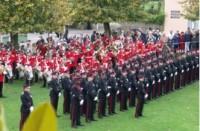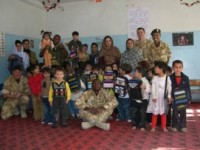Home of the Infantry Regiments of Berkshire and Wiltshire
The Royal Gloucestershire, Berkshire and Wiltshire Regiment
The Royal Gloucestershire, Berkshire and Wiltshire Regiment was formed from a merger of the Gloucestershire Regiment with the Duke of Edinburgh’s Royal Regiment. Inspired by actions of its forefathers, the Regiment wore the sphinx on the back of the head-dress, an honour descended from the Glosters. The red Brandywine Flash (triangle) behind the front badge and the China dragon on the buttons derive from the Duke of Edinburgh’s Royal Regiment, who in turn inherited them from the Royal Berkshire Regiment. Likewise the cross pattee on the front badge comes through the Duke of Edinburgh’s Royal Regiment links from the Wiltshire Regiment. These were all daily reminders of our proud heritage.

At the time of the amalgamation on 29 April 1994, the Regiment comprised the 1st Battalion, all the Army Cadet Force (ACF) in Gloucestershire and Wiltshire, the majority of the ACF in Berkshire and a large proportion of (what was then) Avon. Eleven schools throughout our area had Combined Cadet Force contingents and some 18 months later the 2nd (Volunteer) Battalion, with its headquarters based at Reading joined the regimental family. Finally, former members of all the previous regiments became part of the new Regiment by belonging to the Regimental Association, which continues today and provides comradeship and benevolence in time of need.
CATTERICK AND BOSNIA

Initially the 1st Battalion was based in Catterick in the mechanised role, equipped with Saxon personnel carriers. They received their first colours from our Colonel-in-Chief, HRH The Prince Philip, Duke of Edinburgh, at a superb parade at Windsor Castle in June 1994. On the same parade they were also presented with the United States Presidential Citation, won by the Glosters in Korea, by the Chief of Staff United States Army on behalf of the President.
No sooner had this parade finished when the Battalion was warned for a six-month UN tour in Bosnia. The Dayton Peace Accord was still some months away and the Battalion found themselves deep in the centre of the continuing war torn zone in the enclave at Goradze, with a Company based at Bugojno. Although the tour was marred by the tragic loss of four soldiers killed in two separate vehicle accidents on mountain roads, the Battalion nevertheless quickly established a reputation while there as ‘outstanding’.
CYPRUS
On return from Bosnia in March 1995 the Battalion prepared for the move to Cyprus for a two year tour. Increasing threats from the Middle East terrorists and further reductions in the defence budget influenced operations on the island significantly and the workload increased accordingly. Companies did manage, however, to exercise in Jordan and Egypt, the latter being the first visit by British troops since the 1956 Suez crisis, and later the whole Battalion exercised in Kuwait alongside Kuwaiti forces. During this period the Battalion also found a Company Group to garrison the Falkland Islands for four months. The newly formed 2nd Battalion (Territorials) managed to conduct their summer camp in 1996 alongside their regular counterparts, which was a rewarding experience for both parties.
COLCHESTER AND NORTHERN IRELAND
Returning to England in April 1997, the battalion took up residence in Meanee Barracks in Colchester, adopting the role as an airmobile battalion. After exercising in Canada in late summer, life focused on Northern Ireland training for the oncoming South Armagh tour and, before long, soldiers were on duty providing security in the many now familiar town names of Crossmaglen, Forkhill, Newton Hamilton and Bessbrook. The 'cease-fire' had just been placed in force on arrival and the Good Friday Agreement was imminent. Although military operations slowed elsewhere in the Province, South Armagh changed little and there were significant terrorist incidents approximately every two weeks. During the tour, dissident Republican groups actually stepped up their activity and this culminated in the Omagh bomb, which emphasised the continued need for military presence. The expected peace dividend could not be delivered as quickly as was hoped. Also during this time, due to further cuts in the Defence Budget, it was announced that we would be losing our Territorial Battalion, which dismayed everyone.
On return to Colchester, soldiers hoped for a more settled period to enjoy sport, adventure training and progressive training. 1999 brought to two company sized groups the bonus of overseas exercises; A Company went to Botswana on Ex Diamond Cutter, while C Company deployed to Gibraltar to conduct guard duties at Devil’s Tower Camp and the ‘Convent’, which is the residence of HE The Governor of Gibraltar. The highlight of this expedition was the exercise conducted deep into the tunnels under the Rock. Other events were the successful Greenland expedition and a very good rugby tour to South Africa.
Later that year, world events focussed on Kosovo and, in response to that crisis, NATO prepared to despatch a large intervention force. It became clear that an additional Company Group would be needed to reinforce the 1 R Irish Battle Group, and Imjin Company was formed primarily from A Company personnel. They deployed in May 1999 and advanced into Kosovo with the main force, where they later patrolled the Glogovac area near Pristina, the capital. Their mission was to impose law and order and to provide humanitarian assistance, within an area that had seen up to 90% destruction in the preceding four months. They achieved a great deal in rebuilding the community during their five months there. The remainder of the Colchester period was spent getting ready for the residential tour in Northern Ireland in Ballykinler, which was due to start in April 2000.

BALLYKINLER
In the early part of the following year, before deployment, there was enough time to receive the Freedom of Tewksbury and, later, those of both Windsor and Maidenhead. The two Territorial companies, based at Reading and Gloucester respectively, were now well established and began to flourish. Although over 100 under strength, the 1st Battalion morale was high as they occupied Abercorn Barracks on the South Down peninsular. Life established a predictable routine and there was much time to conduct regular and realistic training. Lieutenant General Kevin O’Donoghue was appointed to be the new Colonel of the Regiment as Major General Robin Grist prepared to stand down after seven long and successful years in that appointment. At the end of the year B Company escaped to Belize for Exercise Native Trail to conduct jungle training and, in sport, the Battalion won the Army Novice and Open Team Championships at Judo.
2001 saw the arrival of No 8 Company Coldstream Guards as reinforcement company, which eased the burden of operations considerably on an undermanned battalion. The highlights for this year concentrated on two Regimental Celebrations, namely the 50th anniversary of the battle of Imjin and 200th of Alexandria and Copenhagen, an event which centred on Gloucester Cathedral in April, at which both the Colonel in Chief and Deputy Colonel in Chief attended. The second event was the 50th anniversary visit to Korea as part of the UN commemoration at the UN cemetery in Pusan, attended by a large number of Gloster veterans and a few serving officers and soldiers. Also in April, the Battalion won the Kingsholm Rugby Sevens and, later that year, the Infantry sevens. In August, A company had their chance to conduct jungle training in Belize, a welcome break and very different scenery to that of the Emerald Isle. In November the Battalion was awarded the Gold medal in the Cambrian Patrol Competition.
HOUNSLOW
2002 produced another move and fresh hopes for new challenges in the form of a Public Duties Battalion to be based in Hounslow, London. Efforts to tailor 400 smart uniforms for Royal inspection became critical, although C Company quickly slipped away for an overseas exercise to Jamaica on Red Stripe during April and May. After the Major-General’s Inspection in early May, the Battalion conducted their first Windsor Castle Guard on 18 May and, on a following hot sunny day, they were on guard at Buckingham Palace. In June, the whole Battalion lined the Strand during the formal Queen’s Golden Jubilee Parade celebrations – a memorable event. Later in the year the Battalion was on parade again at the splendid occasion of the Freedom of Bristol, conducted on the College Green, accompanied by a composite TA Company, and a combined ACF/CCF contingent. Not surprisingly, the Battalion was already preparing for a return to Northern Ireland, this time as Province Reserve (reinforcement battalion), and due to fireman’s strike action it very quickly turned into reality. For the following 4 months the Battalion hopped back and forth from Hounslow to meet demands of province commitments.
Other opportunities that year saw the Mortar Platoon deploy to Canada, training teams operating in Saudi Arabia, Nepal and Canada, and sporting events which brought more successes to those teams involved. The Battalion also managed to conduct a full scale KAPE Tour around the county recruiting area in July. In 2003 the rugby team fought their way through to the Army Cup final, beating the Duke of Wellington’s Regiment in a close semi-final. On a memorable rain stormy day in Larkhill on 5th March, the Battalion team (Slashers RFC) narrowly defeated the Royal Welch Fusiliers 22-20 to win the Army Cup.
Royal Guard duties followed for a period, before troops were again deploying overseas for training, this time to Malaysia. It was announced that the Battalion was earmarked to be posted to Germany as an Armoured Infantry Battalion for a six year tour starting in early 2005, a move greeted with enthusiasm by soldiers and officers alike. The remaining few months of the year were spent preparing for the major exercise in Kenya, Ex Grand Prix. This was a very successful training event and allowed the Battalion to conduct demanding and realistic military manoeuvres in a very different environment from that normally experienced. On return to Hounslow at the end of February 2004, a one week period in camp and 3 days at Norfolk were all that existed before the Battalion flew out as part of the Spearhead Land Element to reinforce Kosovo NATO operations. Departing on 18 March, the Battalion augmented KFOR operations based in Pristina; their arrival had an immediate and significant effect on the civil disturbances, which had been progressively building up into extremely tense inter-sectarian hostilities. Merely a month later, the situation was deemed sufficiently stable to release the Battalion back to the UK. The summer months saw more routine activity taking place: A Company ran the NCO Cadre, a composite group deployed to the Falkland Islands in July for 4 months duty and, in the London District athletics championships, the Battalion were worthy winners. A Company prepared and ran the support effort for the Cambrian Patrol Competition in the autumn. The Battalion team again won a Gold medal.

In October there were three Freedom Parades: Abingdon on 9th Oct followed by Salisbury on 16th Oct and then Stroud on 6th Nov. Later in the year the rugby team flew out to Italy on 11 November for 12 days and conducted a memorable tour gaining considerable rugby experience as well as many cultural benefits. A great year culminated with the devastating announcement that the Regiment was due to be disbanded, which arrived just before Christmas leave. This was some two months later changed into a revised amalgamation with the Devonshire and Dorset Regiment and then subsequently a merger into a newly formed large regiment to be called The Rifles.
2005 witnessed many changes. Firstly, the previously announced plan to move to Germany was revoked. The new plan involved a move to Chester in August 2005 followed by an operational tour to Afghanistan at the end of the year for a six month period. This was seen as a positive step in a most unsettled time and allowed for continuation training to occur. In the early part of the year, Support Company won the Hobbs Cup and the Battalion deployed to Salisbury Plain for an exercise in Copehill Down in March. A sweet victory for the rugby team in another (third in succession) Army Rugby Cup final was achieved, this time against the Royal Scots in a close game (31-24). Exercise Red Stripe in Jamaica, from 11 April to 6 June, essentially became the NCO Cadre, which was an excellent experience for young talented soldiers and their instructors alike. 17 May saw the Battalion involved in the state opening of Parliament and the remaining few months in Hounslow were spent packing and conducting early training for the upcoming Afghanistan tour.
Other notable achievements recorded this year were the ski team winning the Divisional Championships and Lance Corporal White representing the Army in the inter-service championships a month later. The Guest brothers, Tom and Rupert, qualified for the Isle of Mann TT race in the sidecar event (aptly named Backbadge Racing) and acquitted themselves very well in that gruelling event. The last Buckingham Palace Guard took place on 9th June which paved the way for packing up in Hounslow in preparation to hand over to 1st Battalion, Worcestershire and Sherwood Forester Regiment. On 22nd July, the Battalion paraded on the square at Hounslow to change over to the wearing of the Light Division green beret in preparation for the transfer over to that Division the following year. Officially the Regiment was now titled the Royal Gloucestershire, Berkshire and Wiltshire Light Infantry, which in itself has to be one of the longest titled regiments in the British Army. There were no capbadge or uniform changes at this stage. After a successful move to Chester, field firing took place in Otterburn and Warcop, before first deployment of advance party troops to Afghanistan on 13 September.
AFGHANISTAN TOUR
Much detail is recorded elsewhere on this deployment, but in outline troops were grouped by company and tasks: A Company was Operations Company (QRF) based at Mezar-e-Sharif comprising two rifle platoons, a manoeuvre support platoon and an attached Swedish rifle platoon. Also based in Mezar-e-Sharif was C Company operating as Provincial Reconstruction Teams. B Company was deployed to the capital Kabul as Patrols Company and finally a composite group made up the main effort as the National Army Training Team (ANATT), also based in Kabul. This tour was challenging and eventful and sadly two soldiers died on operations whilst a number had lucky escapes. Whilst there, the Battalion prepared the ground for the start of the NATO deployment into Helmund Province, which was to dominate world news later in 2006.

CHESTER
After returning to UK in April 2006, the Battalion prepared for amalgamation with the DDLI and subsequent merger into the RIFLES.
Throughout this brief period in its history, soldiers of the Royal Gloucestershire, Berkshire and Wiltshire Regiment have been repeatedly tested in every way imaginable. They have met each challenge with confidence, skill and determination. Those who made up the ranks of this fine regiment, whether Regulars, Territorials or Cadets who were drawn from Berkshire, Bristol, Gloucestershire and Wiltshire can be proud of their achievements.